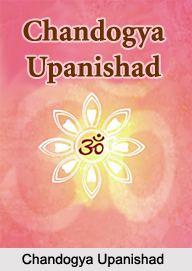 Chandogya Upanishad is one of the oldest Upanishads written on the Vedic Brahmana period about ninth to eighth century B.C. Chandogya Upanishad is associated with Sama Veda. It is the part of Chandogya Brahaman that contains ten chapters. Chapter Four of Chandogya Upanishad has been divided into seventeen Khandas.
Chandogya Upanishad is one of the oldest Upanishads written on the Vedic Brahmana period about ninth to eighth century B.C. Chandogya Upanishad is associated with Sama Veda. It is the part of Chandogya Brahaman that contains ten chapters. Chapter Four of Chandogya Upanishad has been divided into seventeen Khandas.
1st Khanda
The first khanda deals with the Story of Janasruti and Raikva. There was once a king Janasruti, the grandson of Janasruta. One night he saw some flamingos were flying. They spoke about the person Raikva, the man with the cart. The king then began searching for a man who knew about the Supreme Brahman.
2nd Khanda
The second khanda deals with the dialogue of Raikva and Janasruti. The later wanted to know about the deity that Raikva worshipped.
3rd Khanda
The third khanda states about the conversation between Raikva and Janasruti. According to it when fire goes out it is indeed swallowed by the air. Thus, Vayu is the swallower. When water dries up it is swallowed by the air. With reference to the body, the Prana is the swallower. When a man sleeps, speech, sight, hearing and the mind goes into the Prana. There are two swallowers: the air among the gods, the Prana among the senses.
4th Khanda
The fourth khanda states about the story of Satyakama. Once, Satyakama the son of Jabala told his mother that he wished to be a brahmacharin and enquired about his ancestry. His mother however, could not answer his question. Satyakama approached Gautama the son of Haridrumata and told him that he wished to be a brahmacharin. Gautama then asked about his ancestry. Gautama then initiated Satyakama.
5th Khanda
The fifth Khanda deals with the instruction by the bull. It instructed Satyakama about one foot of Brahman. It said that east is one quarter, the west is one quarter, the south is one quarter, the north is one quarter. One who realises this and meditates on the foot of Brahman becomes shining on this earth.
6th Khanda
The sixth khanda deals with the instructions given by Fire. It described about the one foot of Brahman to Satyakama. According to it the earth is one quarter, the sky is one quarter, heaven is one quarter and the ocean is one quarter. One who realises this and meditates on the foot of Brahman becomes endless.
7th Khanda
The seventh khanda deals with the instructions given by Swan. It described about the one foot of Brahman to Satyakama. According to it the Swan Fire is one quarter, the sun is one quarter, the moon is one quarter and lightning is one quarter. One who realises this becomes luminous.
8th Khanda
The eighth khanda deals with the instructions given by the Diver Bird. It described about the one foot of Brahman to Satyakama. According to it the Prana is one quarter, the eye is one quarter, the ear is one quarter and the mind is one quarter.
9th Khanda
The ninth khanda deals with the instructions given by the teacher. Satyakama requested him to teach him.
10th Khanda
The tenth Khanda deals with the story of Upakosala, the son of Kamala. According to it he dwelt as a brahmachirin with Satyakama, the son of Jabala. He had stayed with his teacher for twelve years. Later he was taught about the Supreme Brahman.
11th Khanda
The eleventh khanda states about the instructions given by the household fire to Upakosala. It instructed him that the earth, fire, food and the sun are his various forms.
12th Khanda
The twelfth khanda states about the instructions given by the southern fire. It instructed him that the water, the quarters, the stars and the moon are his different forms. One who realises this and meditates on the fire gets rid off all sinful activities and obtains the world of the Anvaharya Fire. He lives brightly.
13th Khanda
The thirteenth khanda states about the instructions given by the Ahavaniya Fire. It instructed him that the Prana, the akaha, heaven and lightning are his different forms. The one who realises this and meditates on the fire gets rid off all sinful activities
14th Khanda
The fourteenth states about the conversation between the teacher and the pupil. Upakosala was now taught by the teacher the ways of attaining the Self.
15th Khanda
The fifteenth Khanda deals with the instructions given by the teacher. He told that the Self is the person that can be seen in eye. The Brahman is immortal, fearless and all pervading. He is also known as Vamani as he transmits blessings to all living beings. One who is aware of this carries all blessings.
16th Khanda
The sixteenth khanda deals with the silence of the Brahma Priest. One who moves in the air purifies everything. As he purifies everything he is sacrifice. The mind and speech are the two ways of that sacrifice. One of these two is purified by the Brahma priest. The speech is purified by words of the hotri priest, the adhvaryu priest and the udgatri priest.
17th Khanda
The seventeenth khanda deals with the penances for mistakes in the sacrifice. According to it if the sacrifice has certain mistakes with regard to Rig then one should offer a libation in the Ahavaniya Fire.












